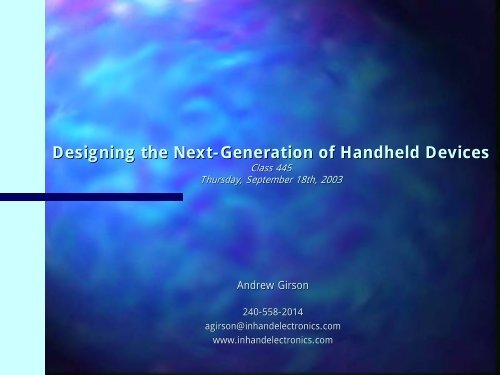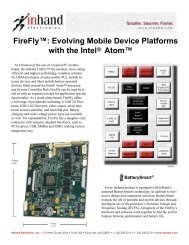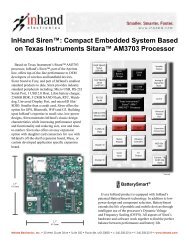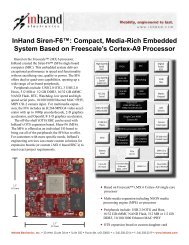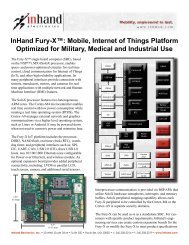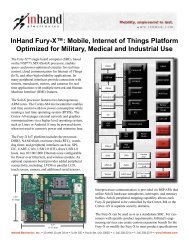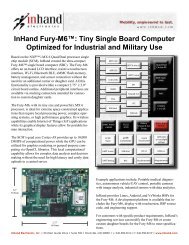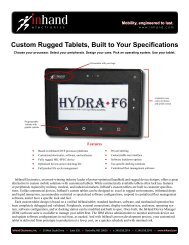Designing the Next-Generation of Handheld Devices
A survey of the significant issues in the A survey of the significant issues in the development of system hardware and development of system hardware and system software for programmable system software for programmable handheld devices, based on 32 handheld devices, based on 32-bit CPUs and operating systems.
A survey of the significant issues in the A survey of the significant issues in the development of system hardware and development of system hardware and system software for programmable system software for programmable handheld devices, based on 32 handheld devices, based on 32-bit CPUs and operating systems.
You also want an ePaper? Increase the reach of your titles
YUMPU automatically turns print PDFs into web optimized ePapers that Google loves.
<strong>Designing</strong> <strong>the</strong> <strong>Next</strong>-<strong>Generation</strong> <strong>of</strong> <strong>Handheld</strong> <strong>Devices</strong><br />
Class 445<br />
Thursday, September 18th, 2003<br />
Andrew Girson<br />
240-558<br />
558-2014<br />
agirson@inhandelectronics.com<br />
www.inhandelectronics.com
Presentation Focus<br />
A survey <strong>of</strong> <strong>the</strong> significant issues in <strong>the</strong><br />
development <strong>of</strong> system hardware and<br />
system s<strong>of</strong>tware for programmable<br />
handheld devices, based on 32-bit<br />
CPUs and operating systems<br />
2
Presentation Overview<br />
Market Opportunity & Design Challenges<br />
How <strong>Handheld</strong> Design is Different<br />
<strong>Designing</strong> a <strong>Handheld</strong><br />
3
<strong>Handheld</strong>s - A Growing Market<br />
Over 400M ARM CPUs shipped in 2001<br />
– majority <strong>of</strong> <strong>the</strong>se CPUs in cellular telephones,<br />
PDAs, and o<strong>the</strong>r wireless devices<br />
Yet, cellular telephone penetration was<br />
just 6% in China in 2000<br />
– US penetration 41%<br />
– Worldwide penetration 12%<br />
4
Mass Markets<br />
Opportunity<br />
– Merging multiple handhelds into one<br />
– Bringing handhelds to everybody<br />
Vertical markets<br />
– Bringing smart handhelds to new segments<br />
– Upgrading “fixed-function” function” handhelds<br />
All Markets<br />
– Leveraging new technologies<br />
5
What This Means for Engineers<br />
Opportunity<br />
<br />
Volatility & Innovation<br />
<br />
Design Challenges<br />
“make it smaller”<br />
“make it hands-free”<br />
“ruggedize<br />
it”<br />
“make it run for weeks on a single charge”<br />
“add location-based services”<br />
“use this new wireless technology”<br />
6
How <strong>Handheld</strong> Design is Different<br />
Designers <strong>of</strong> handheld devices must<br />
overcome all <strong>of</strong> <strong>the</strong> challenges <strong>of</strong><br />
traditional embedded design, yet <strong>the</strong>y<br />
must also…<br />
…make it fit<br />
…make it last<br />
7
How <strong>Handheld</strong> Design is Different<br />
It all comes down to...<br />
“Form Factor” & “Battery Life”<br />
8
<strong>Designing</strong> a <strong>Handheld</strong><br />
Define user requirements<br />
Select a Form Factor<br />
Select a Display<br />
Select Batteries<br />
Select a CPU & OS<br />
Design system hardware platform<br />
Develop system s<strong>of</strong>tware platform<br />
9
Define User Requirements<br />
Will it be used outside?<br />
What types <strong>of</strong> data will be displayed?<br />
How will <strong>the</strong> user input data?<br />
Is it likely to be dropped on a hard surface?<br />
Could it get wet?<br />
Will <strong>the</strong> user have ready access to AC power?<br />
How will <strong>the</strong> user talk to <strong>the</strong> network?<br />
10
Select a Form Factor<br />
PDA<br />
Cell phone<br />
Smartphone<br />
Web Tablet<br />
Wearable Computer<br />
Wireless Terminal<br />
11
Select a Form Factor<br />
Develop mechanical specifications<br />
– Package form factor and materials<br />
– Display, battery, electronics, and input integration<br />
– Manufacturability and assembly issues<br />
– Environmental and ruggedization issues<br />
12
Select a Display<br />
Based on form factor<br />
Based on user interface requirements<br />
Based on ambient environment<br />
indoor, outdoor, readable in sunlight, readable<br />
in low light, viewing angle, orientation<br />
13
Select a Display<br />
Different Technologies<br />
STN, TFT, OLED<br />
reflective, transmissive, transflective<br />
Backlights - CCFT, EL, LED (watch out for<br />
power consumption and noise)<br />
Always get:<br />
a demo <strong>of</strong> <strong>the</strong> working display in <strong>the</strong><br />
environment in which it will be used<br />
a power measurement with and without<br />
backlighting<br />
14
Select Batteries<br />
Two Types <strong>of</strong> Batteries<br />
– Primary<br />
– Rechargeable<br />
Each has advantages and disadvantages<br />
Make sure you estimate battery life for<br />
“likely” user scenarios<br />
15
Characteristics <strong>of</strong> Primary Batteries<br />
Primary batteries have higher energy<br />
density than rechargeables<br />
Carbon-Zinc and Alkaline are commodity<br />
“drugstore” batteries<br />
Lithium batteries are best all-around<br />
around<br />
performers with very flat discharge curves,<br />
high energy density, and excellent shelf<br />
life and low-temperature capacity<br />
16
Comparison <strong>of</strong> Primary Battery<br />
Types<br />
Chemistry<br />
Cell<br />
Voltage<br />
(V)<br />
Cell<br />
Capacity<br />
(mAh)<br />
Gravimetric<br />
Energy<br />
Density<br />
(WHr/kg)<br />
Volumetric<br />
Energy<br />
Density<br />
(WHr/l)<br />
Capacity<br />
loss per<br />
YEAR<br />
(@ 20C)<br />
Carbon- 1.5 10-5000 105-195 100-180 5%<br />
Zinc<br />
Alkaline 1.5 10-5000 125-225 150-440 4%<br />
Silver 1.5 5-200 155-285 250-500 3%<br />
Oxide<br />
Zinc Air 1.4 30-1000 245-455 470-1450 5%<br />
(sealed)<br />
Lithium 1.5, 3.0 10-3000 32-260 340-500 1%<br />
17
Characteristics <strong>of</strong> Rechargeable<br />
Batteries<br />
Rechargeable batteries are reusable, reducing<br />
cost and environmental issues<br />
Li-Ion batteries are best performers, but are<br />
costly and require tight control <strong>of</strong> charging<br />
algorithms<br />
NiMH and Li-Ion can be dangerous if<br />
overcharged<br />
NiCad is simpler with better overcharging<br />
tolerance, but lower performing<br />
18
Comparison <strong>of</strong> Rechargeable<br />
Chemistry<br />
Cell<br />
Voltage<br />
(V)<br />
Battery Types<br />
Cell<br />
Capacity<br />
(mAh)<br />
Gravimetric<br />
Energy<br />
Density<br />
(WHr/kg)<br />
Volumetric<br />
Energy<br />
Density<br />
(WHr/l)<br />
Capacity<br />
loss per<br />
MONTH<br />
(@ 20C)<br />
NiCad 1.2 50-5000 55 170 10%<br />
NiMH 1.2 10-5000 70 250 15%<br />
Li-Ion 3.6 25-1600 120 350 3%<br />
19
Battery Life Estimates for Common<br />
Scenarios<br />
PDA - 900mW on; 200mW idle; 5mW<br />
sleep; 1% on time; 3% idle time<br />
– 3 AAA Alkaline cells (Energizer): ~200 hours<br />
– 1 Li-Ion cell (iPAQ): ~200 hours<br />
Smart sensor - 50mW on; 0.5mW sleep;<br />
2% on time<br />
– 3 AAA Alkaline cells (Energizer): ~2700 hours<br />
– 1 Li-Ion cell (iPAQ): ~2900 hours<br />
20
Select a CPU<br />
ARM architecture is entrenched<br />
– Pocket PC now is only on ARM<br />
– PalmOS is now based on ARM<br />
– Intel, TI, Samsung, Sharp, Atmel, , Philips, and Motorola<br />
all have ARM CPUs specifically targeted at handhelds<br />
MIPs and x86 have intriguing options<br />
– AMD (Alchemy and Geode)<br />
21
Select a CPU<br />
Important features<br />
– Power modes (run, idle, sleep, and more…)<br />
– Voltage and clock scaling<br />
– Lots <strong>of</strong> peripheral integration and I/O<br />
– On-chip memory<br />
– “Stacked” memory<br />
22
Select an Operating System<br />
Palm OS is market leader<br />
Will licensing restrictions loosen?<br />
Micros<strong>of</strong>t’s Pocket PC is coming on strong<br />
Will it overtake Palm?<br />
Symbian<br />
Linux<br />
Strong in cellular (Java)<br />
Will embedded growth translate to handhelds?<br />
23
Hardware Platform<br />
Power Supply<br />
Test & Debug<br />
Memory<br />
User Input<br />
LCD<br />
Audio<br />
Communications<br />
Expansion<br />
24
Hardware Platform - Power Supply<br />
Regulators<br />
Linear<br />
– Cheap & simple, low noise<br />
Switched-Mode<br />
– High efficiency<br />
Boost Supplies<br />
Allow operation from fewer/smaller batteries<br />
Watch out for current transients<br />
Segment <strong>the</strong> power system<br />
25
Hardware Platform - Test & Debug<br />
Small boards limit test points<br />
Small boards limit debug connectors<br />
Options<br />
Single debug connector with all debug hardware on<br />
daughterboard<br />
Large board for development; respin in production<br />
26
Hardware Platform - Memory<br />
Non-volatile<br />
– Linear NOR Flash<br />
– allows XIP, can reduce DRAM requirements<br />
– Linear NAND Flash<br />
– reduces cost, scalable to large densities<br />
– Peripheral Flash Storage <strong>Devices</strong><br />
– can be less expensive, straightforward parameter storage<br />
Volatile/SDRAM<br />
– Must have battery backup<br />
– New CPUs supporting 2.5V (and lower) parts<br />
27
Hardware Platform - User Input<br />
Very dependent on user environment<br />
– Keypads, buttons, and touchpads imply larger<br />
device<br />
– Touchscreens allow smaller device, but can be<br />
fragile and noisy<br />
– Speech input allows small device, but ambient<br />
and audio subsystem noise are issues<br />
28
Hardware Platform - LCD<br />
Very dependent on user environment<br />
– Affects device size<br />
– Affects device battery life<br />
– Different “lighting” techniques<br />
– Watch out for touchscreen pointing<br />
accuracy (noise) with large displays<br />
– Be careful with connector placement<br />
29
Hardware Platform - Audio<br />
Can greatly impact battery life<br />
Audio component placement affects<br />
sound input and output quality<br />
30
Hardware Platform - Comms<br />
Wireless Data and Voice<br />
802.11 is power-hungry<br />
Bluetooth is not ubiquitous<br />
New technologies (e.g., UWB, Zigbee) are<br />
intriguing<br />
Location (GPS)<br />
Component placement affects quality<br />
Many manufacturers are opting for <strong>of</strong>f-<br />
<strong>the</strong>-shelf, plug-in solutions<br />
31
Hardware Platform - Expansion<br />
Standard connectors are flexible, but<br />
drive device size<br />
Daughtercard connectors provide optional<br />
follow-on on development<br />
New peripherals requiring higher speed<br />
busses (USB 2.0, Firewire, GB E<strong>the</strong>rnet)<br />
Make sure peripheral is <strong>of</strong>f or in “sleep”<br />
when not in use<br />
32
System S<strong>of</strong>tware<br />
Power Modes<br />
Frequency/Voltage Adjustment<br />
Interrupt Reduction<br />
Intelligent Waiting<br />
33
System S<strong>of</strong>tware<br />
Power Modes<br />
CPU Power Modes<br />
Run, Idle, Doze, Sleep, Off<br />
Prepare memory for battery backup<br />
Allow instant-on<br />
Set I/O pins properly in Sleep<br />
Peripheral Power Modes<br />
Many peripherals have <strong>the</strong>m<br />
Usage can double or triple battery life<br />
34
System S<strong>of</strong>tware<br />
Frequency/Voltage Adjustment<br />
Power consumption linearly proportional<br />
to CPU core frequency<br />
Power consumption proportional to<br />
square <strong>of</strong> CPU core voltage<br />
Analyze your s<strong>of</strong>tware for periods when<br />
performance is independent <strong>of</strong> CPU<br />
core frequency and adjust accordingly<br />
35
System S<strong>of</strong>tware<br />
Interrupt Reduction<br />
Make interrupt buffers larger<br />
Use DMA whenever possible<br />
Allows CPU to remain in Idle<br />
Reduces interrupt count<br />
Reduces computational bandwidth requirements<br />
36
System S<strong>of</strong>tware<br />
Intelligent Waiting<br />
Avoid “spinning” - try to go to Idle<br />
If “spinning” is unavoidable, can clock<br />
frequency and voltage be reduced?<br />
37
Summary<br />
Hardware, s<strong>of</strong>tware, & mechanical<br />
design teams must interact<br />
mechanical, electrical, and s<strong>of</strong>tware<br />
engineering matters are highly intertwined<br />
Design challenges<br />
Form factor<br />
Battery life<br />
38


